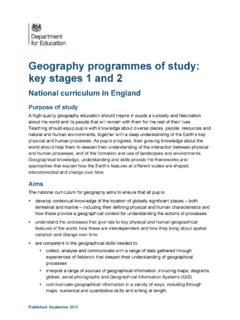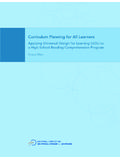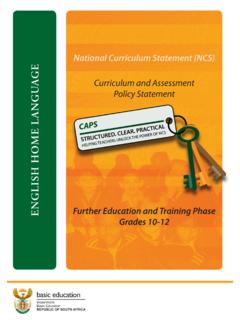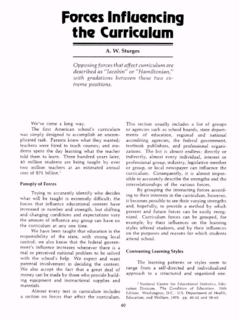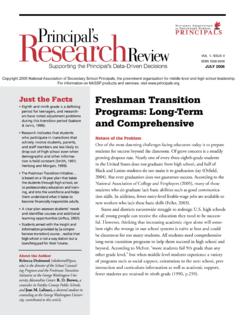Transcription of Broad Lane, Sheffield, S3 7HQ Telephone +44 …
1 Crown copyright (September 2004) Broad Lane, Sheffield, S3 7HQ Telephone +44 (0)114 289 2000 Facsimile +44 (0)114 289 2500 A Review of national Curriculum (5-16 yrs) Guidance of England, Scotland and Wales. Report Number HSL/2005/25 Project Leader: Dr Andrew Weyman Author(s): Dr Peter Shearn & Dr Andrew Weyman Science Group: Human Factors Group 2 CONTENTS 1 Introduction .. 10 Aims & Objectives .. 10 2 Background to School Based Risk Education.
2 12 3 Methodology .. 14 Identifying the Literature .. 14 Content Analysis .. 14 4 The national Curriculum .. 17 The Structure of the national 17 Review and Development of the national Curriculum .. 20 5 Analysis of The Guidance Produced for Teaching Risk Education in England, Scotland and Wales in Six Key Areas .. 22 The national Curriculum Guidelines for England .. 23 The national Curriculum Schemes of Work for England .. 25 QCA Statutory Assessment .. 27 The national Curriculum Guidelines for 27 The national Curriculum Guides for Scotland.
3 29 The national Curriculum Guidelines for 30 Risk Education Programmes and 32 Summary of the Curriculum Authorities Published national Curriculum Guidance 35 6 Educational Assessment and Risk 39 School 39 Examining Boards & Awarding Bodies .. 43 7 The Impact of Health and Safety Regulations upon 47 A Review of Guidance Documents .. 47 8 Other Agencies Impacting Upon Risk Education Delivery .. 50 Teaching 50 Local Education 51 Other Schemes and Government Initiatives .. 52 9 Main Findings .. 53 10 Conclusions ..59 11 References.
4 60 3 EXECUTIVE SUMMARY Objectives The main objectives of this study are as follows: identify the current stakeholders that influence the shape of primary and secondary education; identify any documentary guidance that may be produced by those stakeholders, for example: guidance produced by the Department for Education and Skills (DfES); guidance produced by the Curriculum Authorities for England, Scotland and Wales; guidance produced by regulatory authorities, for example, the Health and Safety Executive, the British Standards Institute; guidance provided by Local Education Authorities (LEAs); guidance documentation produced by professional bodies; published literature and other mediated accounts / debates in the public domain.
5 Assess the risk education content of relevant documents. Main Findings 1) There are many actors influencing the shape of education and the national Curricula of England, Scotland & Wales. On a day-to-day basis schools are directly responsible for interpreting the national Curriculum and delivering a school curriculum that is relevant to their particular context. The national Curriculum acts as policy guidance and is by no means a constraint on education practice. Indeed, each national Curricula encourages schools to adapt lessons in relation to the availability of local skills, interests and resources.
6 In addition to the influence that the teaching staff have over the delivery of the national Curriculum, it is also likely that the pupils background and their parents expectations will shape the delivery of the national Curriculum. At a policy level, perhaps the most apparent means for influencing the shape of the national Curriculum is through the curriculum review process ( the Curriculum Authorities programmes of curriculum monitoring and evaluation). Engagement within a review will depend on the actors conducting or commissioning the review, their criteria for selecting relevant participants and the designated scope of the review.
7 More proactive forms of influence over the curriculum could presumably be achieved by contacting specific branches of the curriculum authorities, and registering an interest in the shape and direction of the curriculum. HSE has already engaged with the curriculum authorities and the national departments for education. The outcome, as documented here, has been a comprehensive inclusion of health and safety issues throughout the curricula literature and related materials. 2) There are no mandatory requirements within the national Curricula guidance documents for schools to teach risk education.
8 The strongest endorsement for health and safety education was found in the English national Curriculum where there was a general teaching requirement for health and safety; roughly summarised, the requirement held that pupils should be taught about risks and hazards associated with certain activities. There were similar endorsements for health and safety education within the national Curricula literature for Scotland and Wales. These curricular requirements have some clear overlap with the statutory requirements for health and safety.
9 4 The three nation s national Curricula guidance documents provide a large number of recommendations for lessons that include opportunities for pupils to learn about subject related risk, health and safety issues. The documents also include more specific recommendations for topics through which pupils can explore related risks and learn about safe and healthy practices.
10 This literature does not, however, provide teachers with detailed lesson plans, prescriptions or recipes for best practice in risk education topics. Given that national Curricula documents do not provide any substantial guidance on best practice in risk education, we anticipate that for most risk-related topics the risks are not considered to present any special challenges to schools and their teaching staff. Where specific risks are recognised, teachers are recommended to refer to standard procedures or regulations, or may require accredited qualifications (especially in the case of PE and D&T).










